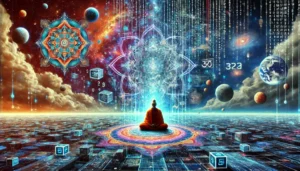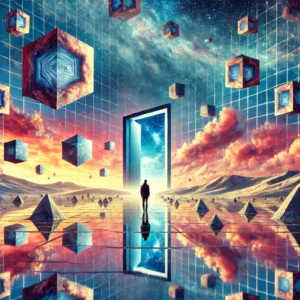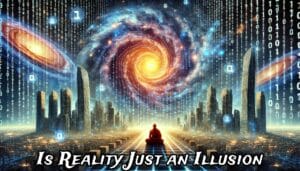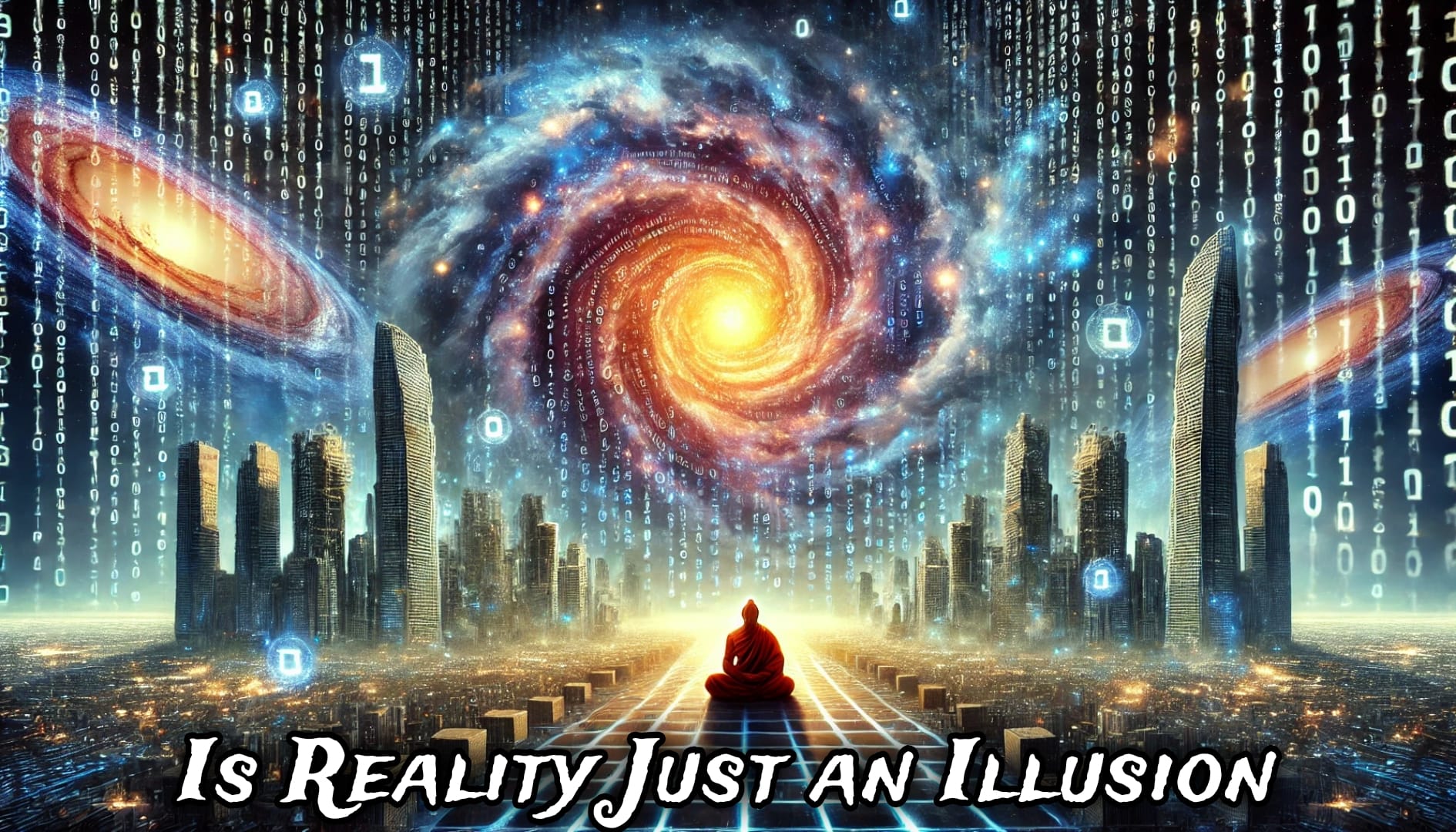
Is Reality Just an Illusion
The Simulation Hypothesis & Hindu Maya – Is Reality an Illusion?
Introduction
Have you ever felt like life is a dream, a play, or something unreal? What if the world you see, touch, and experience is not what it seems? The Simulation Hypothesis suggests that our entire reality might be a highly sophisticated computer program, much like a virtual game. While this idea sounds like modern science fiction, ancient Hindu philosophy has long described the world as Maya, an illusion crafted by a higher consciousness.
Both perspectives question the very nature of reality. If science and spirituality are converging on the same truth, does that mean we are indeed living in a fabricated reality? Let’s explore how Hinduism’s concept of Maya and the Simulation Hypothesis align and whether they reveal the ultimate truth about our existence.
What is the Simulation Hypothesis?
The Simulation Hypothesis was proposed by Swedish philosopher Nick Bostrom in 2003. His argument revolves around three possibilities:
- Civilizations go extinct before developing advanced simulations.
- Advanced civilizations exist but choose not to create simulations.
- We are most likely already living in a simulation created by an advanced intelligence.
Bostrom’s idea gained mainstream popularity when tech visionaries like Elon Musk claimed that the chances of us not living in a simulation are one in billions. Scientists, including Neil deGrasse Tyson and Brian Greene, have considered it a serious possibility.
The core idea is simple: If we humans are close to creating virtual reality and artificial intelligence, an advanced civilization could have already done so—running countless simulations where conscious beings (like us) believe they are real.
This raises a profound question: Are we just digital consciousness inside a programmed world?
The Hindu Concept of Maya – The Grand Illusion
Thousands of years before modern science, Hinduism described the world as an illusion (Maya). According to the Advaita Vedanta school, reality as we perceive it is not the ultimate truth. The true essence of existence is Brahman—the eternal, infinite consciousness beyond time and space.
The Bhagavad Gita and Upanishads repeatedly emphasize that the physical world is an illusion that traps souls into believing in a false sense of reality. The great sage Adi Shankaracharya argued that people mistake this temporary, ever-changing world for something real, leading to suffering and attachment.
Hindu scriptures describe Maya as:
- A deceptive veil covering the true nature of existence.
- A dream-like state, where everything we experience is fleeting.
- A false identification with the physical body and mind, preventing us from realizing our true divine nature.
The only way to break free from this illusion, according to Hinduism, is through self-awareness, meditation, and spiritual enlightenment.

Is Reality Just an Illusion
Table of Contents
Similarities Between the Simulation Hypothesis & Hindu Maya
Despite originating from different traditions, the Simulation Hypothesis and Hindu Maya have remarkable similarities:
| Aspect | Hindu Maya | Simulation Hypothesis |
|---|---|---|
| Illusory Nature | The physical world is not real but a temporary illusion. | The universe is a digital simulation, not true reality. |
| A Higher Creator | Maya is created by Brahman, the supreme consciousness. | The simulation is created by an advanced civilization or intelligence. |
| Multiple Layers of Reality | Different levels of consciousness exist beyond Maya. | There could be multiple simulations or nested realities. |
| Escaping the Illusion | One must attain self-realization to break free. | Recognizing the simulation may allow transcendence or control. |
| Dream-like State | Life is like a dream, constantly changing and temporary. | Reality could be like a hyper-realistic video game. |
Both perspectives suggest that what we perceive as reality is not the absolute truth.
Scientific Evidence Supporting the Simulation Hypothesis
If reality is a simulation, there should be signs within our universe that point to artificiality. Some intriguing scientific observations suggest this could be the case:
- The Observer Effect in Quantum Physics
- In quantum mechanics, particles behave differently when observed.
- This suggests that reality is not independent but rather “renders” when we look at it—just like graphics in a video game.
2. The Mathematical Nature of Reality
- Scientists have discovered that the laws of physics contain deep mathematical codes, similar to computer programming.
- Theoretical physicist James Gates found a binary error-correcting code (similar to what computers use) embedded in string theory equations.
3. Digital “Pixelation” of Reality
- Some physicists argue that at the smallest scales, the universe appears quantized, like pixels in a digital screen.
- If the universe were truly continuous, such limits would not exist.
These findings make it seem as if our reality is being computed at a fundamental level, much like a simulation.
Breaking the Illusion – Spiritual vs. Technological Paths
If reality is an illusion, how do we escape it? Hinduism and simulation theory suggest different but interconnected answers:
- Hinduism’s Path to Enlightenment
- Hinduism teaches that breaking free from Maya requires deep meditation, self-inquiry, and detachment from material illusions.
- By realizing our true nature (Atman), we merge with Brahman and transcend this illusory world.
2. Simulation Theory’s “Glitch” Hypothesis
- Some believe that if we recognize the “glitches” in reality, we might be able to manipulate the simulation.
- Could advanced technology allow us to hack the system and see beyond?
Both perspectives emphasize awareness as the key to transcending illusion—whether through spiritual awakening or scientific discovery.
What Happens After Death? Rebirth vs. Exiting the Simulation
Hinduism teaches reincarnation, where souls are reborn in different lives based on karma. This aligns with the simulation concept, where consciousness could be uploaded or transferred into new avatars after each cycle.
- In Hinduism, death is merely an exit from one illusion before entering another.
- In simulation theory, if we are simulated beings, death could mean either waking up in the “real world” or being rebooted in another simulation.
Both ideas challenge the conventional view of death as an absolute end. Instead, they suggest a continuous cycle of existence beyond the physical world.

Is Reality Just an Illusion
Conclusion – Are We Living in an Illusion?
The similarities between Hindu Maya and the Simulation Hypothesis are too strong to ignore. Both suggest that:
- Reality is not what it seems.
- A higher intelligence (Brahman or a simulator) governs our experience.
- Breaking free from this illusion is the key to discovering the ultimate truth.
So, are we just characters inside an advanced simulation? Or is Maya simply a spiritual illusion created by Brahman?
Perhaps, the answer lies not in technology but in self-awareness and enlightenment. Whether we call it escaping the simulation or attaining Moksha, the ultimate goal is to transcend illusion and reach a higher understanding of existence.
What do you think? Are we in a simulation or trapped in Maya? Share your thoughts below!
FAQs on “Is Reality Just an Illusion? The Simulation Hypothesis & Hindu Maya Explained”
- What is the Simulation Hypothesis?
The Simulation Hypothesis suggests that our reality is actually a highly advanced computer simulation, similar to a virtual world created by an advanced civilization. This theory is supported by thinkers like Nick Bostrom and Elon Musk.
- How does Hinduism describe reality as an illusion?
In Hindu philosophy, the concept of Maya refers to the illusory nature of the physical world. According to Vedanta, what we perceive as reality is just a temporary projection, while the ultimate truth is Brahman, the eternal and unchanging consciousness.
- Are the Simulation Hypothesis and Hindu Maya similar?
Yes, both ideas challenge the notion of objective reality. The Simulation Hypothesis suggests a digital illusion, while Hinduism describes Maya as a metaphysical illusion. In both cases, what we perceive is not the ultimate truth.
- What evidence supports the Simulation Hypothesis?
Some arguments for the Simulation Hypothesis include:
- The rapid advancement of virtual reality and AI
- The mathematical nature of the universe
- Quantum physics phenomena, like the observer effect
- The possibility that an advanced civilization could simulate consciousness
5. What does Hinduism say about escaping the illusion of Maya?
Hindu philosophy teaches that one can transcend Maya through self-realization, meditation, and spiritual wisdom. Practices like Jnana Yoga (path of knowledge), Bhakti Yoga (path of devotion), and Dhyana (meditation) help seekers understand their true nature beyond illusion.
- Could we ever prove that we live in a simulation?
It is difficult to prove, but some scientists suggest looking for glitches in reality, like inconsistencies in physics or computational patterns in nature. However, just like Maya, if we are inside the illusion, recognizing it can be challenging.
- Does this mean free will is an illusion too?
If we are living in a simulation, our choices might be pre-programmed or influenced by the simulation’s rules. Similarly, Hinduism suggests that Karma and destiny shape our experiences, but self-awareness can lead to liberation (Moksha).
- What happens if we break free from Maya or the Simulation?
In Hinduism, realizing the illusion of Maya leads to Moksha—liberation from the cycle of birth and death (Samsara). If we were in a simulation and broke free, it could mean discovering a higher reality or creator outside the simulation.
- How does this relate to other spiritual traditions?
Many spiritual traditions, including Buddhism, Gnosticism, and even some interpretations of Christianity, talk about the world being an illusion or a temporary construct, urging seekers to look beyond material reality for true enlightenment.
- What are some must-read books on this topic?
- “Simulation and Simulacra” – Jean Baudrillard
- “The Matrix and Philosophy” – William Irwin
- “The Self-Aware Universe” – Amit Goswami
- “The Tao of Physics” – Fritjof Capra
- “Advaita Vedanta: A Philosophical Reconstruction” – Eliot Deutsch
Summary
The idea that reality might be an illusion has been a subject of deep contemplation in both ancient spiritual traditions and modern scientific theories. The Simulation Hypothesis, popularized by philosopher Nick Bostrom and endorsed by figures like Elon Musk, proposes that our universe could be an advanced digital simulation, much like a highly sophisticated computer program. According to this theory, a highly evolved civilization might have created simulated realities so complex that conscious beings within them—like us—would be unable to distinguish them from an actual physical world.
This concept aligns intriguingly with the ancient Hindu philosophy of Maya, which suggests that the material world is not the ultimate reality but rather a deceptive veil that obscures the true nature of existence. Hindu scriptures, particularly those in Advaita Vedanta, describe Maya as a force that binds human perception to an illusory world, making it seem real while the ultimate truth—Brahman (the formless, eternal consciousness)—remains hidden. The Bhagavad Gita and Upanishads teach that only through deep wisdom and self-realization can one transcend this illusion and perceive the absolute reality.
Modern science also contributes to this discussion. Quantum mechanics has shown that at the most fundamental level, reality behaves in mysterious ways—particles exist in superpositions, observation alters reality (wavefunction collapse), and time and space might not be as rigid as they seem. Some scientists argue that these findings support the idea that reality is not as objective and independent as we assume.
By comparing the Simulation Hypothesis with Hindu Maya, this article examines the possibility that what we perceive as “real” is actually a construct—either programmed by an advanced intelligence or shaped by cosmic consciousness. Are we living inside a digital simulation created by a higher civilization? Or is our existence merely a temporary illusion in the grand cosmic play of consciousness? Exploring these profound questions can reshape our understanding of life, existence, and the nature of the universe itself.
Unlock the Ancient Wisdom of Sanatan Dharma – Join Us on YouTube!
👉 Subscribe now to Prachin Sanatan Dharma and embark on a journey of enlightenment.
Explore timeless teachings, spiritual insights, and cultural richness on our YouTube channel, Prachin Sanatan Dharma. Dive deep into the essence of Sanatan Dharma through captivating videos that inspire and educate.
Related Articles
- Restful Nights: Ayurvedic Remedies and Traditional Indian Practices to Overcome Insomnia and Late-Night Habits
- The Tridevi: Lakshmi, Saraswati, and Parvati – Their Roles and Powers
- “Divine Creatures of Ancient Indian Scriptures: Exploring the Role of Animals in the Vedas, Puranas, and Mahabharata”
- Nature and Spirituality: Exploring the Sacred Essence of the Himalayas, Ganga, and Other Natural Wonders”
- “Reviving the Gurukul System: Relevance and Lessons for Modern Education”
- “Exploring Greek and Indian Mythology: Similarities Between Greek and Indian Mythology “
- “Embracing Sattvic Living: Harmonizing Mind, Body, and Soul Through Food and Lifestyle”
- “Charity and Prosperity: Exploring the Concept of Daan and Its Financial Relevance in Modern Life”
- How to Build an Eco-Friendly Home Inspired by Vastu Shastra
- Comparison of Ancient and Modern Sports: How Traditional Sports Have Influenced Contemporary Games
- “Timeless Lessons from Ancient Tales: Linking Samudra Manthan and Ganga’s Descent to Modern Ecological Challenges”
- “Reviving Sanskrit: How AI is Preserving Ancient Languages for the Future”
- “Mathura: The Sacred Land of Lord Krishna’s Divine Leelas”
- Investing for Future Generations: Lessons from Indian Traditions on Legacy Building and Wealth Preservation
- “Ancient Indian Wisdom: Timeless Lessons for Tackling Today’s Climate Crisis”
- “Artificial Intelligence and Spirituality: Transforming Ancient Practices for the Modern World”
- “Gold and Real Estate in India: Timeless Assets Shaping Financial Strategies”
- Tradition Meets Innovation: The Evolution of Technology in Hindu Rituals
- End-of-World Myths: Exploring Kali Yuga in Hinduism and Ragnarök in Norse Mythology
- Garuda, Pegasus, and Dragons: The Universal Ties of Mythical Beasts Across Cultures
- “Ancient Vimanas: Mythical Flying Machines or Evidence of Advanced Technology?”
- Time Travel in Hindu Mythology: The Fascinating Tales of Kakudmi and King Raivata
- “Divine Feminine Power in Hindu Mythology: The Legends of Durga, Saraswati, and Lakshmi”
- “Divine Beings of Sanatan Dharma: The Spiritual Significance of Sacred Animals in Hinduism”
- “Symbolism in Mythological Art: Unlocking Hidden Meanings in Ancient Temple Carvings”
- “Exploring Technological Advancements in Ancient India and Civilizations: Vimana, Metallurgy, & Water Management systems”
- Unveiling the Mysteries: Ancient Temples of Sanatan Dharma , Mysterious Temples of India
- “The Scientific Knowledge of Sanatan Dharma: Ancient Wisdom Meets Modern Science”
- Ancient Indian Sports and Games: Celebrating a Legacy of Skill, Strength & Strategy”
- “Exploring the Cosmic Link: The Connection Between Astronomy and Vedic Astrology”
- The Power of Sanskrit: Unlocking the Divine Language of the Gods
- “The End of Kaliyuga: A Sanatan Insight into the World’s Final Chapter”
- Explore more articles on Prachin Sanatan Yuga.
Is Reality Just an Illusion Is Reality Just an Illusion Is Reality Just an Illusion Is Reality Just an Illusion Is Reality Just an Illusion Is Reality Just an Illusion Is Reality Just an Illusion Is Reality Just an Illusion Is Reality Just an Illusion Is Reality Just an Illusion Is Reality Just an Illusion Is Reality Just an Illusion Is Reality Just an Illusion Is Reality Just an Illusion Is Reality Just an Illusion Is Reality Just an Illusion Is Reality Just an Illusion Is Reality Just an Illusion
Is Reality Just an Illusion Is Reality Just an Illusion Is Reality Just an Illusion Is Reality Just an Illusion Is Reality Just an Illusion Is Reality Just an Illusion Is Reality Just an Illusion Is Reality Just an Illusion Is Reality Just an Illusion Is Reality Just an Illusion Is Reality Just an Illusion Is Reality Just an Illusion Is Reality Just an Illusion Is Reality Just an Illusion Is Reality Just an Illusion Is Reality Just an Illusion Is Reality Just an Illusion Is Reality Just an Illusion
The idea that reality might be an illusion has been a subject of deep contemplation in both ancient spiritual traditions and modern scientific theories. The Simulation Hypothesis, popularized by philosopher Nick Bostrom and endorsed by figures like Elon Musk, proposes that our universe could be an advanced digital simulation, much like a highly sophisticated computer program. According to this theory, a highly evolved civilization might have created simulated realities so complex that conscious beings within them—like us—would be unable to distinguish them from an actual physical world.
